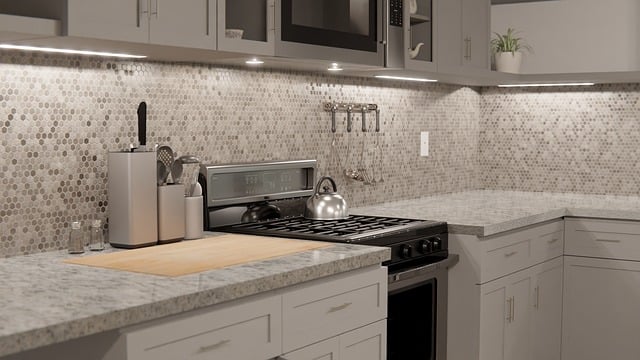When remodeling a kitchen with accessibility in mind, prioritize adaptive features and adhere to ADA-compliant design principles. This includes barrier-free layouts, smooth surfaces, pull-out shelves, ergonomic elements, and wheelchair navigation ease. Such upgrades cater to individuals with disabilities, enhancing convenience, independence, and inclusivity for all users, while transforming kitchens into user-friendly, accessible spaces. Key features include adjustable countertops, touchless technology, ample clear space, and tailored solutions that align with ADA guidelines and promote a safe, enjoyable cooking environment.
Transforming your kitchen into a space that caters to all users is not just beneficial—it’s essential. For individuals with disabilities or limited mobility, a well-designed kitchen can significantly enhance daily routines and independence. This article explores how installing pull-out shelves and drawers can be a game-changer, offering easy reach and improved accessibility during your next kitchen remodel. We’ll guide you through understanding accessibility needs, designing an ADA-compliant layout, incorporating adaptive features, and choosing ergonomic solutions for a barrier-free kitchen experience.
Understanding Accessibility Needs in Kitchen Remodels
When planning a kitchen remodel, understanding accessibility needs is crucial for creating a functional and inclusive space, especially for those with disabilities or mobility challenges. Incorporating adaptive features into your kitchen design can significantly enhance daily routines and overall ease of living. An ADA-compliant (Americans with Disabilities Act) renovation focuses on providing barrier-free access and ergonomic solutions to ensure everyone can navigate the kitchen safely and comfortably.
Consider implementing pull-out shelves and drawers as part of your accessible kitchen design. These features offer easy reach for items stored within, promoting independence for individuals using wheelchairs or having limited dexterity. By optimizing storage with such innovations, you create a more efficient and user-friendly kitchen environment, catering to the specific needs of all users, regardless of their physical abilities.
Designing an ADA-Compliant Kitchen Layout
When planning a kitchen remodel with an emphasis on accessibility, it’s crucial to embrace ADA-compliant design principles. These guidelines ensure that everyone, regardless of physical ability, can navigate and use the space comfortably. One key aspect is creating a barrier-free layout. This involves removing any obstacles or steps within the kitchen, making it wheelchair-friendly. Opt for smooth, flat surfaces and consider designing pull-out shelves and drawers at counter height—a simple yet effective adaptive feature that promotes easy reach for those using a walker or wheelchair.
Additionally, incorporating ergonomic elements can significantly enhance the space for individuals with disabilities. This includes strategically placing appliances and fixtures to reduce strain on joints and muscles. Adaptive kitchen features such as adjustable-height countertops or built-in technology controls can further contribute to a more accessible environment. Such thoughtful design choices not only cater to those with disabilities but also offer benefits for all users, promoting convenience and inclusivity in the heart of your home.
Incorporating Adaptive Features for Disabilities
When planning a kitchen remodel with an eye towards accessibility and inclusive design, incorporating adaptive features is essential. This goes beyond basic usability for all individuals to ensure compliance with ADA (Americans with Disabilities Act) guidelines, promoting a truly barrier-free environment. For instance, installing pull-out shelves and drawers provides easier access to items for those with mobility challenges, aligning with the ergonomic principles of an accessible kitchen design.
Consider wheelchair-friendly layout adjustments like lower counter heights to accommodate users in wheelchairs or with limited mobility. Adaptive features can further enhance functionality through touchless technology, adjustable height work stations, and ample clear space for navigation, making your kitchen remodel a game-changer for individuals with disabilities.
Benefits of Barrier-Free Kitchen Upgrades
Upgrading your kitchen with pull-out shelves and drawers offers numerous benefits, especially for those with disabilities or limited mobility. An accessible kitchen design, like an ADA-compliant renovation, can significantly enhance daily routines and make meal preparation more comfortable and efficient. By implementing barrier-free features, such as wheelchair-friendly layouts and ergonomic adaptive kitchen tools, individuals with disabilities can navigate their culinary space safely and independently.
These upgrades not only promote accessibility but also contribute to a more enjoyable and inclusive cooking environment for everyone. A well-planned barrier-free kitchen layout ensures easy reach to stored items, reducing the need for awkward stretches or constant steps up and down. This results in improved comfort, reduced strain, and increased confidence while handling everyday kitchen tasks, fostering a sense of autonomy and independence for all users.
Choosing Ergonomic Pull-Out Shelves and Drawers
When considering a kitchen remodel with a focus on accessibility and ease of use for all, selecting the right pull-out shelves and drawers is paramount. These functional features can significantly enhance a space designed for individuals with disabilities, ensuring easy reach to stored items. Look for ergonomic options that are not only ADA-compliant but also tailored to the specific needs of your users.
Choosing pull-outs with adjustable heights and smooth, easy-to-operate mechanisms ensures comfort and accessibility for those using wheelchairs or having limited mobility. Adaptive kitchen features like these can transform a standard layout into a barrier-free environment, promoting independence and safety in one’s own home.
When remodeling your kitchen to enhance accessibility and accommodate various disabilities, incorporating pull-out shelves and drawers is a smart choice. These ergonomic features not only improve ease of use but also align with best practices for ADA-compliant kitchen renovations. By choosing the right pull-outs tailored to individual needs, you can create a barrier-free kitchen layout that serves as a testament to inclusive design—a true game changer in terms of functionality and independence for all users, including those relying on wheelchairs or other adaptive aids.
